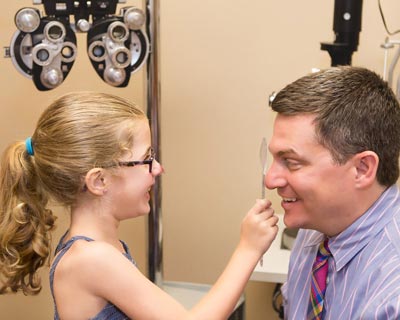Ophthalmologist Helps Young Girl Gain Upper Hand on Life-Threatening Disease
Ask Callie Efurd what she’s excited about, and she will tell you: starting kindergarten.
Judging from the 4-year-old’s outbursts of song and endless hours playing outdoors, most people would assume she was perfectly healthy. But a trip to an ophthalmologist last year revealed that Callie had a rare genetic disorder.
If left undetected and untreated, it could have put her at high risk of sudden death.
Eye Exam Leads to Early Diagnosis of Marfan Syndrome

Callie, who wants to be a doctor one day, with her ophthalmologist Aaron M. Miller, MD. Photo courtesy of: Holly Davis Photography
Callie’s parents, Justin and Jamie Efurd, noticed their daughter consistently held objects close to her face. It was as though she had trouble seeing things.
“We started to worry that something wasn't right,” Jamie Efurd said.
The couple took their daughter to see a pediatrician who performed an eye screening for vision problems. She failed all of the tests. She was referred to Houston ophthalmologist Aaron M. Miller, MD.
Dr. Miller is a pediatric ophthalmologist, a physician who specializes in medical and surgical eye care for children. He performed a comprehensive dilated eye exam on Callie and found several abnormalities. She was very nearsighted for her age and had dislocated lenses. Her dislocated lenses caused her to develop amblyopia and strabismus, or what are more commonly known as lazy eye and wandering eye. Dr. Miller also noticed Callie was tall and had long and slender limbs and fingers.
“I’m just glad we caught the disease when we did,” Dr. Aaron Miller
Based on her eye condition and physique, Dr. Miller knew Callie had signs of having a rare disease called Marfan syndrome. He had to break the difficult news to Callie’s parents that she could possibly have the condition, which can lead to early death if not diagnosed and treated properly.
“I’m just glad we caught the disease when we did,” Dr. Miller said.
Signs and Causes of Marfan Syndrome
Marfan syndrome is a genetic disorder of the body's connective tissue, which holds organs and muscle in place and is a key component in joints. According to the Marfan Foundation, about 200,000 Americans are diagnosed each year. Due to its rarity and related lack of public awareness about the disease, it is estimated that nearly half of people with Marfan syndrome do not know it.
Nearly half of people with Marfan syndrome do not know it.
A person with the syndrome produces a defective version of the protein fibrillin due to a gene mutation. Three out of 4 people with Marfan syndrome inherit it from a parent. A parent with Marfan syndrome has a 50-50 chance of passing the defective gene along to his or her children. In about one quarter of cases, Marfan syndrome is not inherited. This was the case with Callie.
Symptoms can involve many different parts of the body, such as the heart, bones and eyes. Often people with Marfan syndrome are evaluated for the disease because of its effect on their skeletal development. Someone with Marfan syndrome is usually very tall, thin and loose-jointed. When they stretch out their arms from their sides, their arm length from one side to the other can be greater than their height.
How Marfan Syndrome Affects Vision
Callie, like many people with Marfan syndrome, had ectopia lentis. With this condition, the small fibers that hold the lenses of the eye in place develop abnormally or break. As a result, the lenses can become dislocated, making vision worse. This condition is a key symptom of Marfan syndrome and is often the first sign of the disorder.
Marfan syndrome can also cause several other treatable eye diseases, including cataracts and glaucoma. For instance, children with Marfan syndrome may develop cataracts at a younger age. If cataracts do develop, cataract surgery can be performed to improve their vision.
Because Marfan syndrome affects the eye, people with the condition should be checked regularly by their ophthalmologist.
Detecting Life-Threatening Diseases through the Eyes
If not for the eye exam with Dr. Miller, Callie and her parents would have no clue that she was at risk.
While vision is a concern for people with the condition, the greatest threat for patients with Marfan syndrome has to do with their hearts. The aorta can enlarge, which increases the risk for tearing or rupture. This makes undiagnosed patients with Marfan syndrome vulnerable to sudden death if they engage in intense physical exertion.
In fact, the average life expectancy for people who have Marfan syndrome but are undiagnosed is 32.
If not for the eye exam with Dr. Miller, Callie and her parents would have no clue that she was at risk.
The eye is the only place in the body where a doctor can have an unobstructed view of the blood vessels, nerves and connecting tissue — without any need for surgery. Because the eye has the same microscopic tissue as our other major organs, and is an important part of our larger nervous system, abnormalities spotted in the eye may signal the same changes in other parts of the body.
“We, as ophthalmologists, have the training to examine the eyes as a window to many systemic diseases that can affect the whole body,” said Dr. Miller. “This expertise gives us the unique advantage to sometimes detect and diagnose diseases before they’re visible to the patient or even other physicians.”
Callie is just one of two patients Dr. Miller has diagnosed with Marfan syndrome in the past 10 years. But, today, he treats about 10 patients who have been referred to him after other physicians diagnosed the disease.
Managing Marfan Syndrome with Ophthalmic and Cardiac Care and Vigilance
“Because Callie’s diagnosis happened so young, were we able to begin treatment and manage her symptoms very early…Dr. Miller truly saved her life.” – Jamie Efurd, mother of Callie, who has Marfan syndrome
In 2015, doctors performed genetic screening and a heart exam that confirmed Callie’s diagnosis. Since there is no cure for the disease, those affected by Marfan syndrome must focus on proper treatment and management of symptoms.

Callie with her mom, Jamie Efurd, who credits Dr. Miller with saving Callie’s life. Photo courtesy of: Holly Davis Photography
Callie’s parents strive to let her live a normal life. However, certain adjustments are necessary to keep her eyes and body healthy. She takes blood pressure medication and avoids contact sports to protect her heart and eyes. She also limits activity that may involve a constant increase in heart rate. Prescription glasses have improved her vision and eye alignment. She also has follow-up visits with Dr. Miller every three months.
She will need to see an ophthalmologist for the rest of her life to monitor her vision and take early steps to address any changes. Her parents remain optimistic about Callie’s future thanks to Dr. Miller’s diagnosis, which they say gave them an upper hand at managing the disease.
“Because Callie’s diagnosis happened so young, we were able to begin treatment and manage her symptoms very early,” said Jamie Efurd. “It has given Callie a tremendous advantage in overcoming Marfan syndrome. Dr. Miller truly saved her life.”
It’s no wonder that when Callie’s teacher asked her what she wanted to be when she grows up, Callie answered with no hesitation: “A doctor.”